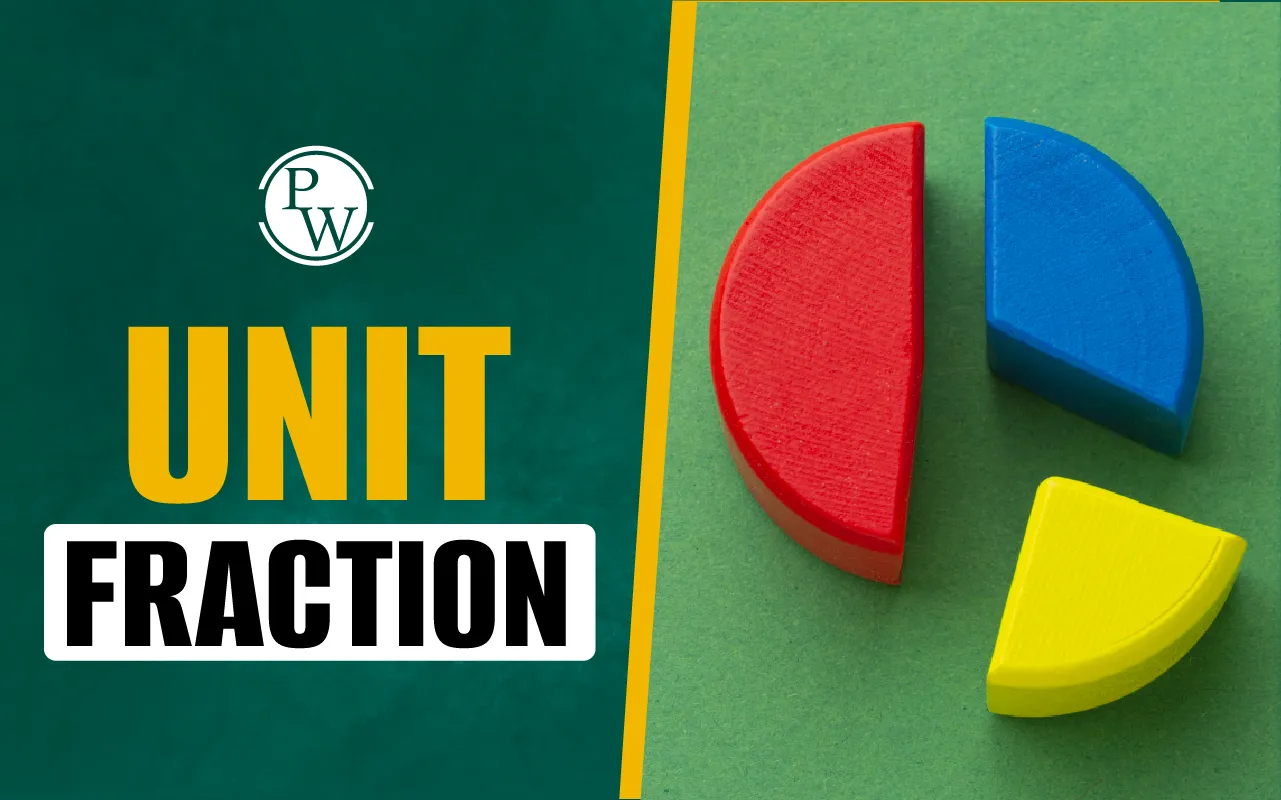

What is the Unitary Method?
The unitary method. It helps us solve problems by first finding the value of one unit, and then using that to find the value of many units. This method is based on proportion, which means when one quantity goes up or down, the other changes in the same way, either directly or inversely.
For example, imagine you buy 4 notebooks for 80 rupees. To find the price of one notebook, you divide 80 by 4. That gives you 20 rupees per notebook. Now, if you want to buy 7 notebooks, you multiply 20 by 7, which is 140 rupees.
This method is called “unitary” because it starts by finding the value of one unit before moving to more.
Read More: Reciprocal - Definition and Examples
Ratio, Proportion and Unitary Method
The unitary method is closely related to ratio and proportion. Let’s break it down.
-
Ratio compares two quantities. For example, if Riya has 2 pencils and Ali has 4 pencils, the ratio is 2 to 4 or 1 to 2.
-
Proportion tells us that two ratios are equal. If 2 pencils cost 10 rupees and 4 pencils cost 20 rupees, then the cost is in proportion.
The unitary method helps us solve problems where we need to find missing values in such situations. First, we find the value of one unit. Then, we use that to find other values.
Read More: Pythagorean Triples - Definition, Formula, Examples
How to Use the Unitary Method?
Follow these simple steps to solve any problem using the unitary method.
Step 1: Identify the one unit
Figure out what “one unit” means in the problem. It could be one pen, one hour, one page, or one chair.
Example: A factory makes 12 chairs using 24 wooden planks. Here, one unit is 1 chair.
Step 2: Check what is given
Look at how many units are mentioned and the total value or quantity given.
Example: 12 chairs need 24 wooden planks. That means 12 chairs = 24 planks.
Step 3: Find the value of one unit
Now divide the total by the number of units to find the value of one.
Example: Planks for 1 chair = 24 ÷ 12 = 2 planks
Step 4: Find the value for any number of units
Multiply the value of one unit by the number you need.
Example: If you want to make 7 chairs:
Planks needed = 2 × 7 = 14 planks
Types of Unitary Method
There are two main types of unitary method:
1. Direct Variation
In direct variation, when one value increases, the other also increases. For example, if the price of one pen is 10 rupees, then the price of 5 pens is 50 rupees. More pens mean more money.
Other examples:
-
More chocolates cost more money
-
More distance needs more time if speed is the same
2. Inverse Variation
In inverse variation, when one value increases, the other decreases. For example, if one person paints a wall in 6 hours, two people can do it faster in 3 hours. More helpers mean less time.
Other examples:
-
More speed means less time to travel
-
More taps filling a tank means less time to fill it
Applications of Unitary Method
The unitary method is very useful in our daily life. Here are some ways it is used:
-
Shopping: To find the price of one item and then buy many
-
Travel: To calculate speed, time, or distance
-
Cooking: To find ingredients for more or fewer people
-
Work: To find how much time different people will take to do a task
-
Business: To calculate cost, profit, or loss
Read More: Basic Geometrical Ideas
Unitary Method Examples
Let us go through some easy examples to understand how the unitary method works in different situations.
Example 1: If 6 pencils cost 30 rupees, what is the cost of 1 pencil?
Solution: We are given the cost of 6 pencils. To find the cost of 1 pencil, we divide the total by the number of pencils.
Cost of 1 pencil = 30 ÷ 6 = 5 rupees
We are finding the value of one unit (1 pencil) from the value of many (6 pencils). This is a direct variation.
Example 2: If 1 pencil costs 5 rupees, what is the cost of 9 pencils?
Solution: Now we know the value of 1 unit. To find the value for more units, we multiply.
Cost of 9 pencils = 5 × 9 = 45 rupees
Once the unit value is known, we simply multiply by the number of items needed.
Example 3: A car travels 180 kilometers in 3 hours. How far will it go in 5 hours?
Solution:
Step 1: Find the distance covered in 1 hour
180 ÷ 3 = 60 kilometers
Step 2: Multiply by the number of hours
60 × 5 = 300 kilometers
The car will travel 300 kilometers in 5 hours.
Example 4: If 4 workers can finish a job in 8 days, how many days will 8 workers take to finish the same job?
This is a case of inverse variation, because more workers will take less time.
Solution
Step 1: First, find the total amount of work in worker-days
4 workers × 8 days = 32 worker-days
Step 2: Now divide the total work by the number of workers
32 ÷ 8 = 4 days
8 workers will take 4 days to finish the job.
The total work remains the same. By increasing the number of workers, each one does less work, so the job gets done faster.
Example 5: If 3 kilograms of rice cost 150 rupees, what is the cost of 5 kilograms?
Solution
Step 1: Find the cost of 1 kilogram
150 ÷ 3 = 50 rupees
Step 2: Multiply to find the cost of 5 kilograms
50 × 5 = 250 rupees
5 kg of rice costs 250 rupees
This is a direct variation. As the number of kilograms increases, the total cost also increases.
Example 6: If 2 water taps can fill a tank in 6 hours, how long will 4 taps take to fill it?
Solution:
Step 1: Total work = 2 taps × 6 hours = 12 tap-hours
Step 2: Divide by the new number of taps
12 ÷ 4 = 3 hours
4 taps will fill the tank in 3 hours
More taps working together will take less time to fill the same tank.
Example 7: A printer prints 180 pages in 6 minutes. How many pages can it print in 10 minutes?
Solution:
Step 1: Pages in 1 minute = 180 ÷ 6 = 30 pages
Step 2: Pages in 10 minutes = 30 × 10 = 300 pages
The printer can print 300 pages in 10 minutes
More time means more pages printed, as the rate stays the same. This is a direct proportion.
Also read: Prime Factorization
Quick Tips to Use the Unitary Method
To use the unitary method correctly, keep these tips in mind:
-
Always find the value of one unit first before doing anything else
-
Multiply the value of one unit to get the value of many units
-
Think carefully about whether the problem involves a direct or inverse relationship
-
Read the question clearly and note down what is given and what you need to find.
Help Your Child Beat Maths Fear with CuriousJr
If your child gets nervous about maths, many students feel the same way. CuriousJr’s Mental Maths Online Classes are designed to turn that fear into confidence by making maths simple, fun, and easy to understand.
Here’s how CuriousJr helps children enjoy learning maths:
-
Interactive Live Classes – Engaging online sessions that make learning maths enjoyable right from home.
-
Personal Guidance – Every child receives attention from expert teachers who help them in the areas they struggle with most.
-
Homework and Doubt Support – Regular sessions ensure your child never feels stuck or confused.
-
Daily Progress Reports – Track your child’s improvement and watch their confidence grow each day.
-
Flexible After-School Schedule – Classes that fit smoothly into your child’s routine without extra stress.
-
Fun Mental Maths Practice – Activities covering patterns, sequencing, and simple tricks for faster calculations.
Book a demo class today and watch your child overcome their fear of maths, one fun lesson at a time.
Unitary Method FAQs
What is the unitary method?
Where is the unitary method used in real life?
Does unitary method help in understanding percentages?
Is unitary method a part of all maths exams?
What is the difference between direct and inverse unitary methods?













